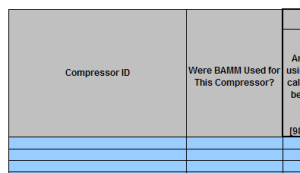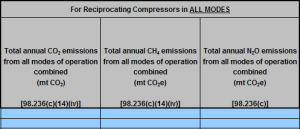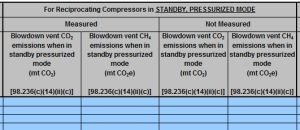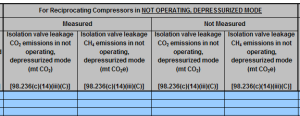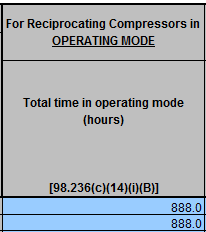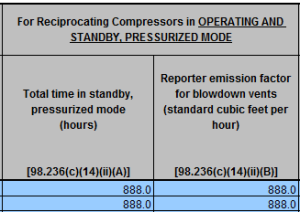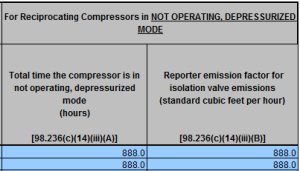Please see Reporting Form Instructions on downloading the blank reporting form and uploading the completed reporting form.
You may also refer to Optional Calculation Spreadsheet Instructions to download the Subpart W calculation spreadsheet.
This page provides an overview of the Subpart W reciprocating compressors source category e-GGRT reporting requirements.
The reciprocating compressors source category is applicable to Onshore Petroleum and Natural Gas Production, Onshore Natural Gas Processing, Onshore Natural Gas Transmission Compression, Underground Natural Gas Storage, Liquefied Natural Gas (LNG) Storage, and LNG Import and Export Equipment.
Indicate if the facility has the source type via the radio buttons.
- If the source type is present you must report required elements.
If the facility has the source type, the Best Available Monitoring Methods and Missing Data table must be completed.
- For further information, see Best Available Monitoring Methods and Missing Data Reporting.
Reciprocating Compressor Reporting (Onshore Petroleum and Natural Gas Production)
The reporting requirements for Onshore Petroleum and Natural Gas Production differ from the rest of the industry segments for this source type. For Onshore Petroleum and Natural Gas Production, only the following data elements are required to be reported:
- The total annual CO2 emissions from all compressors combined, in metric tons CO2 [98.236(c)(14)(v)(B)]
- The total annual CH4 emissions from all compressors combined, in metric tons CO2e [98.236(c)(14)(v)(B)]
- Count of compressors [98.236(c)(14)(v)(A)]
Reciprocating Compressor Reporting (Onshore Natural Gas Processing, Onshore Natural Gas Transmission Compression, Underground Natural Gas Storage, Liquefied Natural Gas (LNG) Storage, and LNG Import and Export Equipment)
All applicable industry segments other than Onshore Petroleum and Natural Gas Production must report emissions individually for each reciprocating compressor.
For each compressor, emissions will be reported by mode of operation. Three modes of operation that require emission monitoring are the operating mode, standby, pressurized mode, and the not operating, depressurized mode. Emissions from each mode of operation must be reported if the compressor was ever in that mode at any time during the year.
For each emission source, there are separate reporting fields for if the emission source was measured during the year or if the emission source was not measured and a default emission factor was applied. If one or more sources for a compressor were measured during the year, the emissions should be filled in for the respective measured fields. For any sources that emissions were not directly measured, the not measured field should be reported in place of the measured fields. If BAMM was used and no emission sources were measured, the compressor specific BAMM field should be reported as “yes”, and only the not measured emission fields should be reported. If BAMM was not used in place of direct measurement of at least one mode, then “no” should be entered for the BAMM field. The measured and not measured fields should never both be populated for a given compressor and source type.
The exact reporting requirements are described below:
Operating Mode
(required if compressor was ever in that operating mode at any time during the year) | Required Data Elements |
All Compressors |
|
Operating Mode |
|
Standby, Pressurized Mode |
|
Not Operating, Depressurized Mode |
|
For Reciprocating Compressors Venting Emissions to FLARES |
|
For Reciprocating Compressors in OPERATING MODE |
|
For Reciprocating Compressors in OPERATING AND STANDBY, PRESSURIZED MODE |
|
For Reciprocating Compressors in NOT OPERATING, DEPRESSURIZED MODE |
|
The total emissions roll-up at the top of the sheet reflects the sum of the CO2 equivalents of each gas emission reported for the source type. These summations are reflected and aggregated on the Introduction tab.Total Emissions




